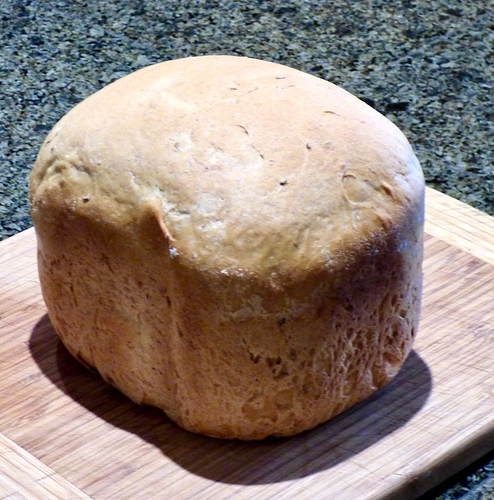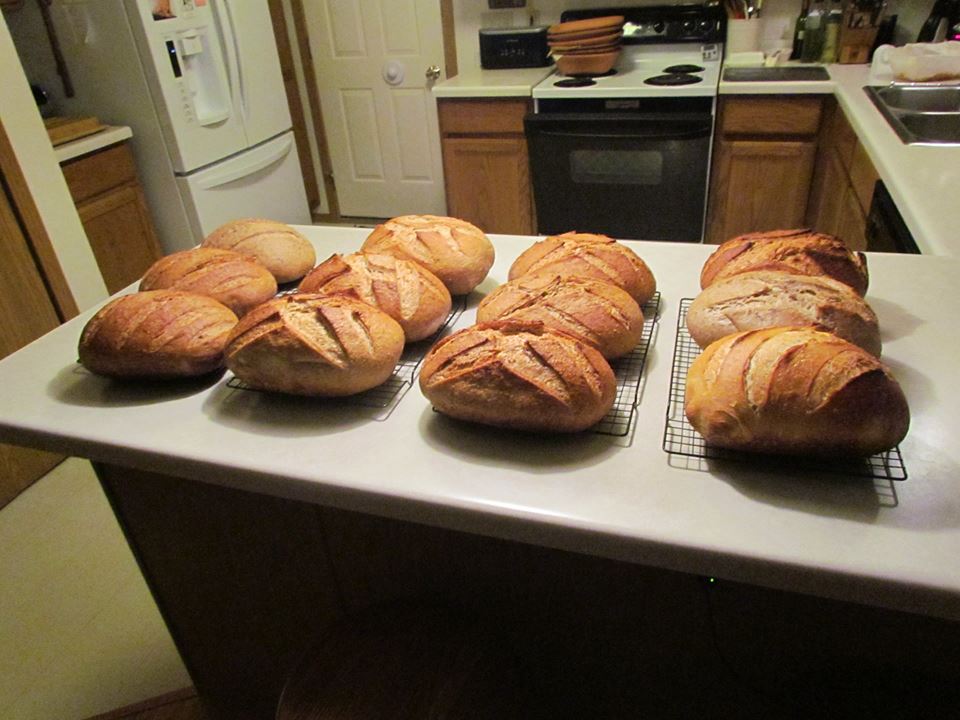Tried a Rye sourdough recipe from King Arthur and it was a disaster. Came out looking like a congealed buffalo turd, no rise with the consistency of concrete on the feet of a mafia turncoat “feeding the fishes.” Next attempt was just plain rye flavored with caraway seeds without sourdough. The result was heavenly, light as a featger and better than anyone with a halo could have baked. So obviously the problem was with my rye starter, nurtured and fed for 8 days. Picture of the good loaf attached. Too embarrassed to show the bad.
That’s some fine turn of phrase and imagery  as well as a lovely loaf of bread. Have you tried using your rye starter on other flours. You could test it that way to determine if it has the wild yeasts and bacteria.
as well as a lovely loaf of bread. Have you tried using your rye starter on other flours. You could test it that way to determine if it has the wild yeasts and bacteria.
An earlier batch of the same starter produced a halfway decent sourdough loaf made with all-purpose white flour, still a little dense but perfectly edible, and I figured I’d do a bit of tweaking with hydration to get a lighter weight in my regular sourdough. The rye sourdough experiment was just that, a whim. Never tried it before and made it without molasses, egg and honey as called for in the KA recipe, while adhering to the recommended amounts of starter, white flour, rye flour and water. I’m not much on sweet bread and figure those sweeteners would have made it even heavier.
Hi @jensholg! I have to agree with @Fermentada Melissa on your wording and imagery! I loved it. I wonder about something. Here on the forum I’ve read how a number of bakers use and swear by the results of their rye sourdough starter. About a year ago I decided to make a rye sourdough starter to see if I got better results than with my original organic white AP flour sourdough starter, Cyril. I took a portion of Cyril and fed him just fresh milled rye and spring water to develop him. I called him Sir Riehold. I experimented with baking the same bread recipe with each starter. I did not notice any appreciable difference in the final loaves. At that time I determined, for my baking anyway, that I really didn’t need two starters. Cyril was my faithful and true happy starter. I ended up making some pancakes out of Sir Riehold (yeah, rye pancakes, LOL, a little dense and heavy) because I have a hard time discarding starter and decided to only maintain one starter, my faithful Cyril. So I’m wondering, are you only interested in using a rye starter or do you have a plain AP flour starter as well? When I use Cyril to bake my rye breads they do just fine. In fact, Cyril is the ONLY starter I use in all my breads. If I’m rambling on please forgive me. I’ve typed this first thing this morning without my morning coffee!
Leah
So far I’ve made three starters, one with white bread flour, one with whole wheat flour and the last with rye. I tried the rye because I’ve read the same rave reviews as you, Leah, but found that all three starters performed pretty much the same. Most of my past bread-making was confined to French bread, but I’m a newbie to sourdough, racking up several flops and one decent but not amazing loaf. I’m still trying to determine just how wet or how dry the starter should be.
I also don’t see a big difference once the starter is active, but I have found rye starters easier to, well, start. I also quite like using the rye starter as I find the addition of some rye flour to be a great flavor enhancer.
For bread flour or whole wheat starters, I go 100% hydration. For a rye starter, I go 110% or 120%.
Well that’s the first I’ve heard of 110-120% hydration for a starter, even rye. I always thought the less hydration the higher the rise, but then always is a relative term since I’m new to sourdough. Do you get better rise with that hydration or does it give you denser bread?
Too much emphasis is based on how much a starter rises. Yes, a rising starter indicates a strong starter and a healthy yeast population but one has to also consider flour used, hydration, the ratio of starter to flour etc. You’re getting very caught up in the hydration of the starter when it can be anything from a stiff dough to a very wet batter. In other words there is no “correct” hydration. When it comes to sourdough, and baking in general, its whatever works for you be it convenience or preference.
Forget the hydration of a starter for a moment. Take a simple bread recipe with a hydration that works for the flour being used and what type of crumb you want. So for example here is a recipe broken down to 3 ingredients…
- 500g bread flour (100%)
- 350g water (70%)
- 10g salt (2%)
This is the deconstructed loaf in its raw ingredients.
But you need starter in there to make it rise. Starter is flour and water! So however much starter you use, and taking into account the flour to water ratio, you take this from the total flour and water in the recipe. Just exactly how much starter you use will depend on how much time you wish to spend on your dough. More starter = less time and vice versa. Say your starter is 100% hydration and you wish to use 100g = 50g flour + 50g water. So you add in the starter but take off 50g each from the total flour and water, like so…
- 450g bread flour
- 300g water
- 10g salt
- 100g starter @ 100% hydration (50g flour + 50g water)
Voilà. You now have starter and the exact same total flour and water for the bread you wish to make.
It doesn’t matter if the starter is more liquid or more dough like. The process is the same. Hamelman uses a 125% hydration bread flour starter. Because its more wet it encourages lactic acid fermentation and it makes a very flavoursome loaf. He uses a 20% inoculation, so quite a large feed, and I manage to get a good rise from the preferment. Hamelman’s starter and sourdough method has always been one of my all time favourites.
You might want to try this, it’s served me well over the years. 1 cup active starter, 1 cup warm water, 2 1/2 cups white flour, 1 cup rye flour, 1 Tbs caraway, 1 teas kosher salt.
Well, you could try just adding freshly ground rye berries as the flour in your starter (of course you’ll put a bit of Cyril in a separate container to do so, so you won’t contaminate it)-worked for me:-)
@cathrynk, that’s exactly how I made my rye starter to begin with. I took a portion of Cyril, put him in a clean jar and added freshly milled rye berries (I have a Mockmill 100) and pure spring water. I did get a great rye starter I named Sir Riehold. I just personally found no real need to maintain two starters. Of course, if I want to resurrect Sir Riehold I can just make some again. I might at some point, just to experiment again. But for now, I’m quite content with my faithful happy starter, Cyril.
Take care!
Leah

